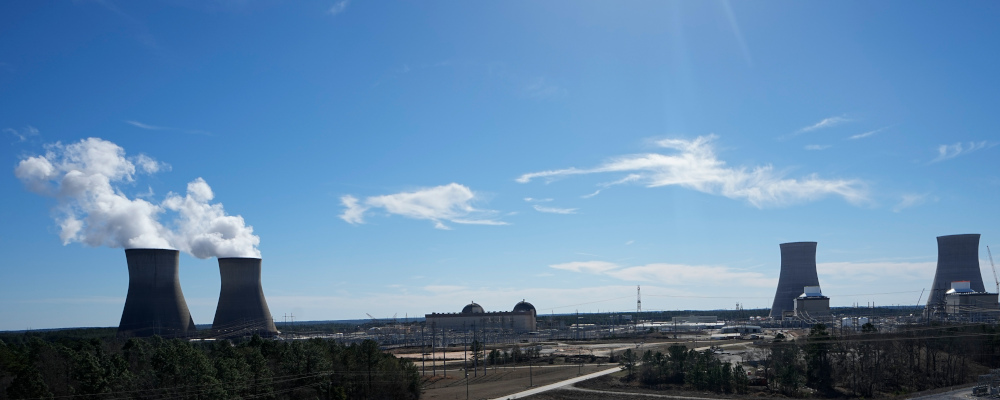In 1950 four countries were on the cutting edge of nuclear technology development: the United States, the USSR, the United Kingdom, and Canada. While it may be surprising today, Canada’s leading role was the product of sustained government support and a bit of luck. As part of the Allied nations during WWII, the country played a strong role in the Manhattan Project that created the first atomic weapons. This gave Canadian scientists a basic level of expertise with the nascent technology at its inception. After the war, this technical expertise was redirected domestically, leading to Canada building the world’s second nuclear reactor at Chalk River, followed by many more discoveries and technical innovations over the subsequent decades.
Yet Canada’s nuclear heritage has all but been forgotten today by the public: the most tangible vestige is the 19 CANDU reactors that operate across Canada. Although nuclear industries globally have remained relatively flat since the 1980s, Canada’s decline has been precipitous. Atomic Energy of Canada Limited, a crown corporation and once the jewel of the country’s nuclear industry, has divested itself of its key divisions including the one responsible for the CANDU reactor.
The diminution of Canada’s nuclear industry can be traced to a number of issues. In the aftermath of the 1979 Three Mile Island and 1986 Chernobyl accidents, regulatory oversight greatly increased the capital costs of building nuclear reactors. This, along with the lack of government loans or other incentives, made atomic energy unprofitable compared to other energy sources. Those alternatives, such as hydroelectric in British Columbia and Quebec, as well as oil and gas elsewhere, largely satiated the country’s energy needs from the 1980s to the 2010s.
However, worries around climate change and greenhouse gases have made fossil fuel approaches less than attractive. And while hydropower remains a viable alternative source, its potential growth remains fairly flat. The challenges encountered by Site-C Dam in British Columbia and the James Bay River project in Quebec suggest that it will not meaningfully shift the energy dynamics of the country in the future.
Furthermore, renewables face real limitations to the scale at which they can meet any developed state’s energy demands.A recent MIT Technology Review article pointed out that real-world evidence from a number of locales suggests that solar energy power likely cannot provide more than 25 percent of a given energy grid’s total energy mix; any more and it becomes less practical and profitable for companies to incorporate. The difficulty of attempting an energy transition without nuclear has become particularly apparent in Germany, which has been required to rely heavily on coal-fired power plants—one of the most CO2-intensive energy sources—to replace the generating capacity lost when it shut down its nuclear power plants.
Realistically, our energy future requires a mix of energy sources. Nuclear is one of the most straightforward approaches Western economies can adopt. Nuclear power provides the flexibility and reliability to complement renewables, which can address their greatest weakness: transience due to climatic conditions. Nuclear can reliably serve as a baseload to meet demand when those other generator sources are unavailable. A 2020 International Energy Agency report found that nuclear had among the lowest expected costs across all low-carbon technologies, including wind and solar.
It would be foolish to ignore some of the challenges that face nuclear power as a source. The Three Mile Island, Chernobyl, and Fukushima meltdowns inflicted grievous damage to the Industry’s reputation, which persists today in many Western countries. A recent Angus Reid poll suggested that while three out of five Canadians want more nuclear development, only 2/5ths of them would welcome the construction of a nuclear plant within 50 km of their home. One could interpret the findings as Canadians being supportive of nuclear power but remaining concerned about its safety.
In some way, the nuclear industry is fighting a battle with its ghosts, not its present reality. The disasters of the ’70s and ’80s spurred the development of new technologies and reactor designs. Those incidents occurred largely at plants or facilities whose creation date back to the inception of the nuclear power industry. For example, the Fukushima-Daichi power plant that melted down during the 2011 tsunami employed a boiling water reactor design that dated back to the early 1960s —one of the first large-scale designs. In that era, the industry’s focus was more on the viability of nuclear power and developing increasingly powerful and efficient reactors. Since the 1980s, safety has become an overriding focus.
The newest generations of large reactors are built with wide safety margins and passive safety features that allow reactors to operate in a safe mode for days without outside assistance. Critical failure points, such as exposed power systems required for cooling the reactors used at Fukushima, have been engineered out.

Perhaps the most exciting advances are in the field of Small Modular Reactors, or SMRs. These reactors are much smaller than existing designs and have the potential to revolutionize power generation in remote communities across Canada. Currently, most of these communities are reliant on diesel power, which is not only carbon intensive but also exposes residents to harmful aerial pollution and requires challenging refuelling operations during narrow seasonal windows. Renewables are not realistic alternatives in these areas given their harsh climactic conditions. The quality of life improvements that SMRs could bring can’t be overstated.Other applications include use as a heating source for major industrial processes, such as in the oil sands or in refining critical minerals such as nickel, a key material for advanced batteries. The U.S. has just authorized the construction of the first such SMRs for Dow Chemical and will certainly pursue more in the future.
The final issue is the handling of nuclear waste, which has vexed the field since its inception. The reality is that the industry itself has become better at reducing the waste produced by fission—reducing the potential risks of a large release in the unlikely case of a failure—and has developed several storage solutions to store everything that cannot be reprocessed. A number of underground geological repositories are in the process of being constructed, with the first opening in Finland last year. Canada has similar plans to construct a repository in Ontario’s Canadian Shield, one of the most stable and oldest geological formations in the world. Once operational, the site will house all of the country’s nuclear waste for at least the next half-century. While the technical challenges are certainly surmountable, developing local support for their construction, especially among First Nations communities, is by no means assured. It speaks to the broader difficulties nuclear energy encounters to gain acceptance.
All of this seems like heady stuff, yet no matter what course Canada’s energy transition takes over the next three decades, the effects will be dramatic on all aspects of Canadians’ lives. The use of nuclear power has the potential to provide the most straightforward, sustainable, and economically beneficial approach. Parts of government have responded. Last week it was announced that the world’s first micro modular reactor (MMR), a type that would be ideal to sustain remote communities, will be built at Chalk River. A good first step.
However, tepid support by the federal government will not be sufficient to push Canada back into the forefront of this field. Rather, it will strangle the little life that remains in this field.
The nuclear field remains heavily regulated, perhaps overly so, in part as a hangover of the disasters of the 1970s and ’80s. The most recently constructed nuclear plant in the United States, Votgle 3, required roughly 15 years to navigate the regulatory approvals process and construct the reactor (though several parts required redesign). Chalk River MMR’s project is anticipated to require a decade from the start of the approval process to its completion. While the latter may be acceptable for a prototype, if later examples face similar timelines it will ensure the technology will remain unprofitable.
A new approach is required that reflects the reality of nuclear technologies today. For example, unlike traditional reactors that are multibillion-dollar bespoke investments, SMRs resemble mass-produced industrial units that should require less regulation after a specific design is approved.
Streamlining the approvals process should be a focus of federal governments. With strong existing demand, the right mix of government support in terms of funding and regulations will ensure nuclear power’s future in Canada may well look as bright as its past.
Recommended for You

The Notebook by Theo Argitis: Mark Carney’s first major tests

The Weekly Wrap: Trudeau left Canada in terrible fiscal shape—and now Carney’s on clean-up duty

‘Another round of trying to pull capital from Canada’: The Roundtable on Trump’s latest tariff salvo

‘We knew something was coming’: Joseph Steinberg on how Trump is ramping up his latest tariff threats against Canada




